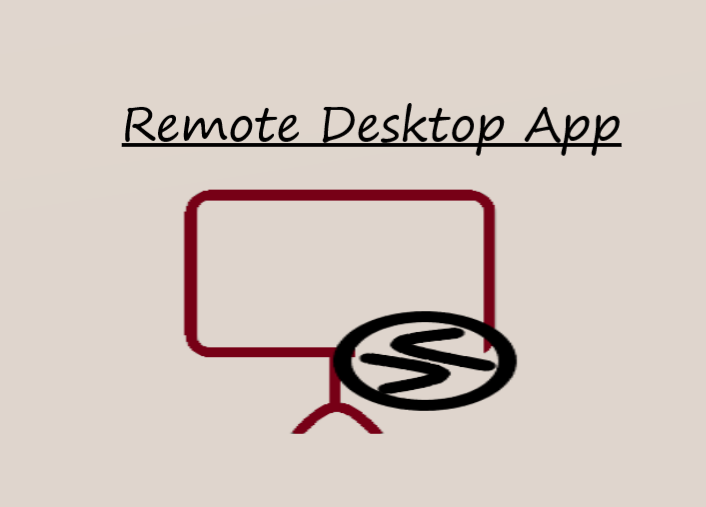Remote desktop app allows you to access a computer or server from a different location. This technology has become essential in today’s world. It helps in remote work, tech support, and managing servers. This guide will explain what a remote desktop app is, how it works, and its benefits and drawbacks.
What is a Remote Desktop App?
Remote desktop app lets you control another computer remotely. You can see its screen, open files, and run programs as if you were sitting in front of it. This is very useful for many tasks, such as:
- Accessing work computers from home
- Providing technical support
- Managing servers and networks
- Running applications on powerful remote machines
How Does a Remote Desktop App Work?
A remote desktop app works by establishing a connection between two devices. Here’s a simple explanation of the process:
- Client and Host: The computer you control is the “host,” and the device you use to control it is the “client.”
- Connection: The client and host connect over the internet or a local network.
- Screen Sharing: The host’s screen is transmitted to the client device.
- Input Forwarding: Your keyboard and mouse inputs on the client are sent to the host.
- Real-Time Interaction: You can interact with the host computer in real-time, as if you were physically present.
Popular Remote Desktop Apps
1. Microsoft Remote Desktop
- Platform: Windows, macOS, iOS, Android
- Features: Secure connection, multi-monitor support, file transfer, remote printing
- Pros: Built into Windows, easy setup
- Cons: Limited features on non-Windows devices
2. TeamViewer
- Platform: Windows, macOS, Linux, iOS, Android
- Features: Cross-platform access, file transfer, remote printing, wake-on-LAN
- Pros: Easy to use, no configuration needed
- Cons: Free version has limitations
3. AnyDesk
- Platform: Windows, macOS, Linux, iOS, Android
- Features: High frame rates, low latency, file transfer, multi-platform
- Pros: Fast and responsive, lightweight
- Cons: Limited free version
4. Chrome Remote Desktop
- Platform: Windows, macOS, Linux, Chrome OS, iOS, Android
- Features: Easy setup, secure connection, access via web browser
- Pros: Free, simple to use
- Cons: Basic features, limited to Chrome browser
5. Splashtop
- Platform: Windows, macOS, iOS, Android
- Features: High-quality video and audio, file transfer, multi-user access
- Pros: Affordable, good performance
- Cons: Requires subscription for full features
Benefits of Using a Remote Desktop App
1. Remote Work
Remote desktop apps make remote work possible. You can access your office computer from home. This ensures you have access to all your files and applications.
2. Technical Support
IT support teams use remote desktop apps to troubleshoot issues on client computers. They can fix problems without being physically present.
3. Resource Management
These apps allow businesses to manage servers and networks remotely. This is especially useful for IT administrators who need to access multiple servers.
4. Flexibility
Remote desktop apps offer flexibility. You can work from anywhere, at any time. This is ideal for people who travel frequently.
5. Cost-Effective
Using a remote desktop app can save money. Businesses can reduce the need for physical office space and equipment.
Drawbacks of Using a Remote Desktop App
1. Security Risks
Remote access can be a security risk. Unauthorized access can lead to data breaches. It is crucial to use secure connections and strong passwords.
2. Performance Issues
The performance of a remote desktop app depends on the internet connection. Slow connections can lead to lag and poor user experience.
3. Complex Setup
Some remote desktop apps require complex setup and configuration. This can be challenging for non-technical users.
4. Limited Features
Free versions of remote desktop apps often have limited features. Full functionality usually requires a paid subscription.
How to Choose the Right Remote Desktop App
When choosing a remote desktop app, consider the following factors:
1. Compatibility
Ensure the app is compatible with your devices and operating systems. Check if it supports both the client and host systems you use.
2. Features
Look for features that meet your needs. Common features include file transfer, remote printing, and multi-monitor support.
3. Ease of Use
Choose an app that is easy to set up and use. A user-friendly interface can save time and reduce frustration.
4. Security
Security should be a top priority. Look for apps with strong encryption and secure connection protocols. Ensure the app supports two-factor authentication.
5. Performance
Check user reviews and performance ratings. Choose an app known for high performance and low latency.
6. Cost
Consider your budget. Some apps offer free versions with basic features. Others require a subscription for full functionality. Choose an app that provides the best value for your needs.
Setting Up a Remote Desktop App
Setting up a remote desktop app is usually straightforward. Here’s a general guide:
1. Download and Install
Download the app on both the client and host devices. Follow the installation instructions.
2. Create an Account
Some apps require you to create an account. Register and log in on both devices.
3. Configure Settings
Configure the settings on the host device. Enable remote access and set permissions. Ensure the device is connected to the internet.
4. Connect
Open the app on the client device. Enter the required details to connect to the host. This may include the host’s IP address or a unique access code.
5. Secure the Connection
Ensure the connection is secure. Use strong passwords and enable two-factor authentication if available.
Conclusion
A remote desktop app is a valuable tool for accessing and managing computers remotely. It is beneficial for remote work, technical support, and server management. When choosing a remote desktop app, consider compatibility, features, ease of use, security, performance, and cost. Popular options include Microsoft Remote Desktop, TeamViewer, AnyDesk, Chrome Remote Desktop, and Splashtop. While remote desktop apps offer many benefits, they also come with security risks and performance issues. By choosing the right app and securing your connections, you can make the most of remote desktop technology.






Leave a Reply